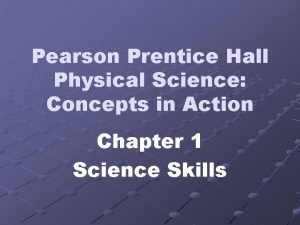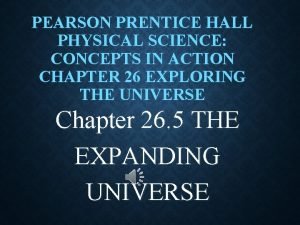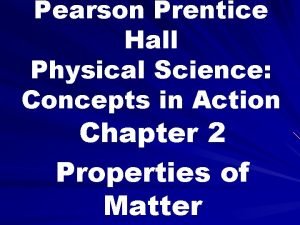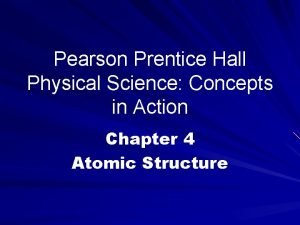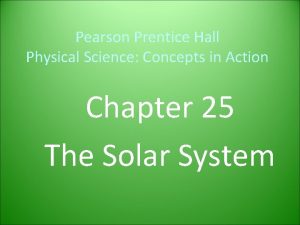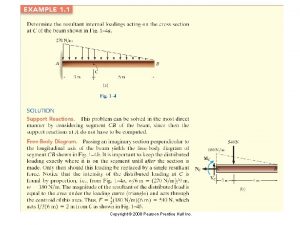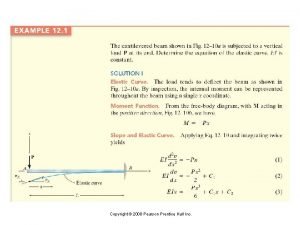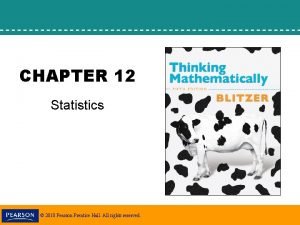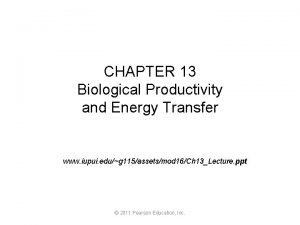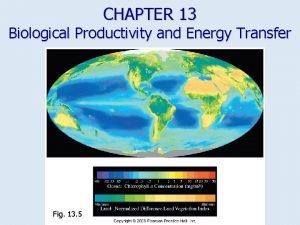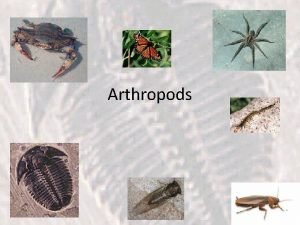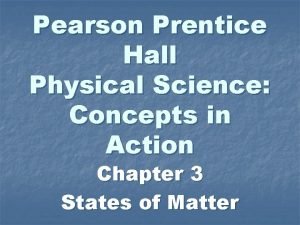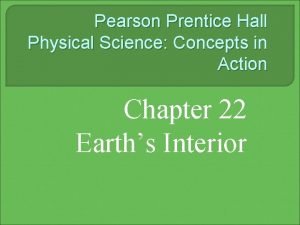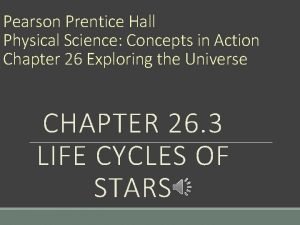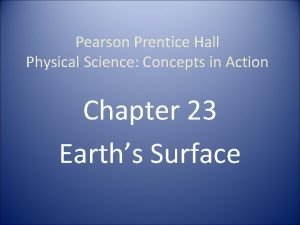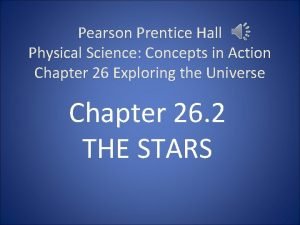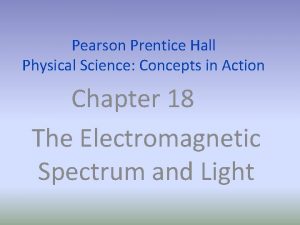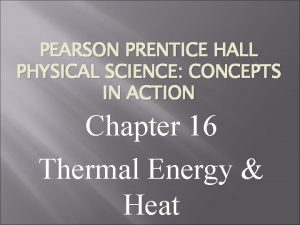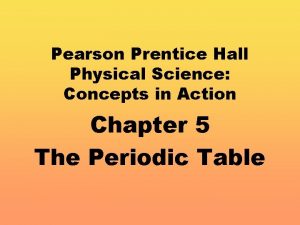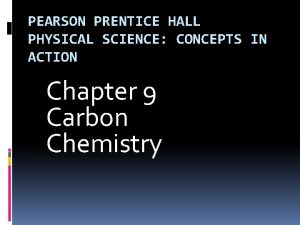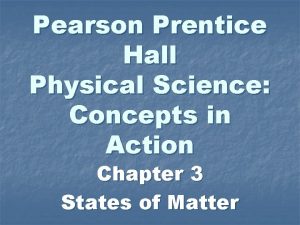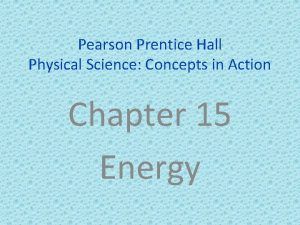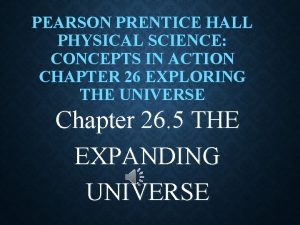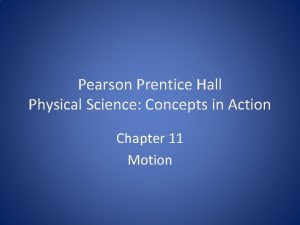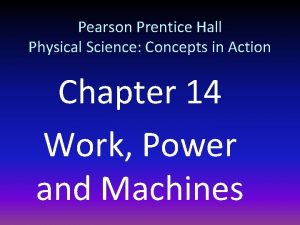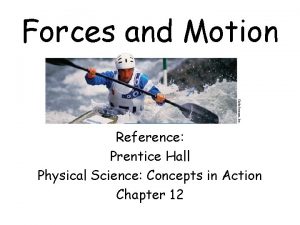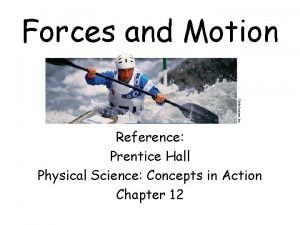PEARSON PRENTICE HALL PHYSICAL SCIENCE CONCEPTS IN ACTION








































- Slides: 40

PEARSON PRENTICE HALL PHYSICAL SCIENCE: CONCEPTS IN ACTION Chapter 26 Exploring the Universe

26. 1 The Sun Objectives: 1. Describe how to produce energy 2. Explain why the sun remains stable over time 3. Diagram and describe the interior structure and atmospheric features of the sun

Stable Over Time/ Interior Structure • • The sun remains stable over time because the inward pull of gravity balances the outward push of thermal pressure from nuclear fusion The three main structures of sun’s interior are the core, the radiation zone and the convection zone The core is the central region where nuclear fusion occurs During fusion, hydrogen and helium fuse to create heavier elements

• • • The radiation zone is a region of highly compressed gas Energy is transferred from the radiation zone to the convection via electromagnetic waves The gas is so compressed in the radiation zone that it can take over 100, 000 years to pass through it The outer layer of the sun’s interior is the convection zone The convection zone receives the energy from the radiation zone Energy is transferred out to the photosphere by convection currents

• • • The sun’s atmosphere consists of three layers called the photosphere, the chromosphere and the corona The innermost layer is the photosphere with a temperature of 5800 K and 500 km thick The photosphere is called the sun’s surface Astronomers cannot see through the photosphere which has a bubbly appearance The chromosphere is just outside the photosphere It is 10, 000 K and is only visible when the photosphere is blocked during a total solar eclipse

The outermost layer of sun’s atmosphere is the corona The gases are so thin in the corona that they are only seen during a solar eclipse The corona thins to become the solar wind Def: the solar wind is a stream of electrically charged particles that flows outward from the sun through the solar system Def: sunspots areas of gas in the photosphere that are cooler than the surrounding gases

Sunspots have cycles and provide astronomers with information about the motions of the sun Scientists discovered that the sun rotates faster at its equator than at the poles by studying sunspots Def: prominences are huge loops of gas that erupt from sunspots Def: solar flares are sudden releases of energy usually near sunspots Solar flares can cause magnetic storms in Earth’s upper atmosphere when additional high energy particles & radiation reach Earth

26. 2 Stars • Objectives: • 1. Demonstrate how distance is measured • 2. Classify stars according to chemical and physical properties

Measuring Distance • Def: a star is a large, glowing ball of gas in space which generates energy through nuclear fusion in its core • Def: a light-year is the unit of distance that light travels in a vacuum in one year • Def: parallax is the apparent change in position of an object with respect to a distant background • Scientists use parallax to measure distances

• Hold your thumb at arm’s length in front of you and cover one eye • Keep your thumb in the same spot & cover the other eye • The apparent movement of your thumb is the parallax effect • Astronomers measure the parallax of nearby stars to determine their distance from Earth

Chemical and Physical Properties • Astronomers classify stars by their color, size, and brightness • Scientists also use chemical composition and mass to classify stars • A star’s color indicates the temperature of its surface • The hottest stars are blue (30, 000 K)& cool stars are red (3, 000 K) • Yellow stars (like our sun) are intermediate temperature (5, 000 -6, 000 K)

• Scientists get more precise information about a star by using color spectra & atomic absorption spectra (to indicate the presence of certain elements) • Def: apparent brightness is the brightness of a star as it appears from Earth • Brightness is affected by distance from Earth • Def: absolute brightness is how bright a light really is • Absolute brightness does not depend on distance & it is calculated using distance in the calculation

How to Produce Energy • It wasn’t until the 1960 s that scientists discovered that the sun produces its energy in its core central region • The process is nuclear fusion • Recall that nuclear fusion has not happened on Earth yet because of the high temperatures required • The temperatures required for nuclear fusion exist on the sun

• Astronomers can use information about temperature and brightness to estimate diameter and calculate volume of a star • Astronomers calculate mass indirectly by observing the gravitational interaction of stars that occur in pairs • There appears to be a relationship between absolute brightness and mass

• Def: absorption lines are a set of dark lines that show where light has been absorbed in the atomic absorption spectra • Each star has its own atomic absorption spectrum which indicates which elements are present in the photosphere • Most stars have a chemical makeup that is similar to the sun • It is mostly hydrogen and helium making up nearly 99% of the star’s mass

26. 3 Life Cycles of Stars • Objectives: • 1. Describe how stars form • 2. Estimate how long a star remains on the main sequence • 3. Predict what happens to a star when it run out of fuel

How Stars Form • Def: a nebula is a large cloud of gas and dust spread out over a large volume of space • Stars form in the densest regions of nebulae • Stars are created by gravity • As the nebula contracts, it heats up, producing a contracting cloud and gas and dust with enough mass to form a star called a protostar • A star is formed when a contracting cloud of gas and dust becomes so dense and hot that nuclear fusion begins

The Main Sequence of a Star • A star’s mass determines the star’s place on the main sequence and how long it will stay there • The mass is determined by the amount of gas and dust available • The most massive stars have the most energy • High mass produces bright blue stars which use up their fuel quickly and last only a few million years

• The fuel is hydrogen and helium which is converted to energy by nuclear fusion producing heavier elements • Middle-sized yellow stars like the sun remain stable for about 10 billion years • Our sun is estimated to be in its prime life at about 4. 6 billion years • Small, cool red stars are long-lived for more than 100 billion years since they use their fuel slowly

Running Out of Fuel • When stars run out of fuel (hydrogen and helium for nuclear fusion reactions) the star dies • The dwindling supply of fuel in a star’s core ultimately leads to a star’s death as a white dwarf, neutron star or black hole • The mass of the star determines whether it ends up as a white dwarf, neutron star or black hole • Low and medium mass stars (red and yellow) can be up to eight times as massive as our sun

• As quantity of hydrogen dwindles, gravity becomes stronger than pressure & core shrinks • Core temperature rises causing the hydrogen outside the shell to begin fusion • Energy flows outward making the star expand & atmosphere cooling in the outer regions causes the star to glow red • Def: a red giant is a large reddish star late in its life cycle that fuses helium into carbon or oxygen

• With decreasing energy from the core and less outward pressure to support the star against gravity’s inward pull, the star collapses producing a glowing cloud of gas • Def: a planetary nebula is the glowing cloud of gas produced by a dying star • The star blows off most of its mass leaving only its hot core • Def: A white dwarf is a very dense star that remains after the fusion in a red giant stops and the star will die

• The white dwarf cannot fuse and cools slowly for an estimated 20 billion years (longer than the current age of the universe) • Our sun will end its life as a white dwarf • The life cycle for a low to medium mass star is nebula: protostar: main sequence star: red giant: planetary nebula: white dwarf • High mass stars have mass greater than eight times that of our sun • Their early life and main sequence are similar to low and medium mass stars

• As high mass start to die, they become red supergiants • Def: red supergiants are extremely large stars that create elements as heavy as iron • As gravity overcomes pressure in massive stars, the collapse is dramatic creating a supernova • Def: A supernova is a powerful explosion that occurs when a massive star dies • The explosion can create elements heavier then iron

• The elements get ejected into space eventually becoming part of other solar systems (like ours) • The iron that exists on Earth came from supernovae that occurred billions of years ago • If the mass after the supernova is less than three times the sun’s mass, the star will die as a neutron star • Def: A neutron star is a dead star with the density of atomic nuclei • For high mass stars: nebula: protostar: main sequence: red supergiant: supernova: neutron star or black hole

• Neutron stars are only a few kilometers in diameter but so dense that they are sometimes detected as pulsars • Def: Pulsars are rapidly rotating sources of radio waves given off by rapidly rotating neutron stars • If the mass after supernova is greater than three times sun’s mass, it will die as black hole • Def: A black hole is an object so massive that not even light can escape its gravity • Black holes are observed indirectly (since no light escapes) by gravitational influence of objects around them

26. 4 Groups of Stars • Objectives: • 1. Explain how stars are distributed in space • 2. Identify basic types of star clusters • 3. Classify galaxies based on their appearance and composition and describe the four main types of galaxies

How Stars are Distributed • Def: Constellations are a group of stars appearing in a pattern as seen from Earth • They are often named after characters from Greek mythology • These patterns seen from Earth are products of the location of stars along our line of sight • Def: a star system is a group o two or more stars that are held together by gravity • Def: a binary star is a star system with two stars • The two stars orbit each other

Star Clusters • There are three basic kinds of star clusters: open clusters, associations and globular clusters • Def: an open cluster has a disorganized or loose appearance & contains no more than a few thousand that are spread out • They often contain red giants & gas and dust • Def: associations are temporary groupings of bright young stars • In time gravity breaks associations apart • Def: a globular cluster is a large group of older stars

Galaxies • Astronomers classify galaxies into four main types: spiral, barred-spiral, elliptical and irregular • Our galaxy with our sun is called the Milky Way • The Milky Way is a spiral shaped galaxy • Recent evidence suggests there is a massive black hole at the center of our galaxy • Spiral shaped galaxies have a bulge of stars at the center with arms extending outward like a pinwheel

• Barred-spiral galaxies have a bar through the center with arms extending outward from the bar on either side • Elliptical galaxies are spherical or oval with no trace of spiral arms • Elliptical galaxies contain only old stars • Irregular galaxies have a disorganized appearance • Def: quasars are enormously bright centers of distant young galaxies • Quasars produce more light than hundreds of galaxies the size of the Milky Way

26. 5 The Expanding Universe • Objectives: • 1. Relate Hubble’s Law to red shifts and to the expansion of the universe • 2. Apply the Big Bang Theory to observations of the present day universe • 3. Describe how dark matter can be detected and explain the importance of its effects on the expanding universe

Hubble’s Law and Red Shifts • Def: The universe is the sum of all matter and energy that exists, that ever has existed, and that ever will exist • In 1929, Edwin Hubble announced that atoms in stars emit light toward the red end of the light spectrum • Hubble’s Law says that the speed at which a galaxy is moving away is proportional to its distance from us

• The Doppler effect is used to determine how fast stars are moving toward or away from Earth • Def: the Doppler effect is the change in wave frequency and wavelength as an object moves toward or away from you • Def: Red shift is a shift toward the red end of the spectrum in the observed spectral lines of stars or galaxies • When a object moves away from Earth, the light source moves away & wavelengths become longer toward the red end of the spectrum

• The red shift means that every galaxy is moving away from Earth & that the universe is expanding • Every galaxy is also moving away from each other implying that the universe is expanding and was once much smaller • The most widely accepted theory to explain this is the Big Bang Theory which states that a gigantic explosion about 14 billion years ago started the universe

The Big Bang • Astronomers theorize that the universe came into being at a single moment in an event called the Big Bang • The Big Bang Theory states that the universe began instant, billions of years ago, in an enormous explosion • The universe expanded quickly and cooled down afterwards

• We will assume the universe is about 14 billion years old • In this theory there is no time, no space and nothing at all before the big bang • Def: Cosmic background radiation which is a steady, dim radiation detected at microwavelengths is believed to support this theory • Expansion is cooling the universe • The red shift also supports theory • Scientists believe that the universe is still expanding today

Dark Matter • Whether or not the universe continues to expand depends on the amount of mass of the entire universe • It is not known for how long the universe will continue to expand • If there is not enough mass, gravity will be too weak to stop the expansion • If mass is just right, expansion will slow down but never stop

• If there is too much mass, gravity will take over and the universe will contract again, causing a “big crunch” & the whole thing could happen again • The amount of matter is determined by matter that can be seen such as stars, and matter that cannot be seen • Def: Dark matter is matter that cannot be seen directly, but its presence can be detected by observing its gravitational effects on visible matter • Dark matter is matter that does not give off radiation

• The universe contains a lot of dark matter • This amount of matter indicates that there is enough mass to keep the universe expanding • In the past, scientists have discovered that the rate of universe expansion may be increasing • Galaxies are moving apart faster than expected • Scientists have named the mysterious force causing this “dark energy” • If expansion is accelerating, it’s likely that the universe will expand forever
 Prentice hall physical science concepts in action
Prentice hall physical science concepts in action Pearson education inc publishing as pearson prentice hall
Pearson education inc publishing as pearson prentice hall Pearson education inc publishing as pearson prentice hall
Pearson education inc publishing as pearson prentice hall Pearson education inc publishing as pearson prentice hall
Pearson education inc publishing as pearson prentice hall Pearson education inc publishing as pearson prentice hall
Pearson education inc publishing as pearson prentice hall 2008 pearson prentice hall inc
2008 pearson prentice hall inc Bacground
Bacground Pearson physical science concepts in action
Pearson physical science concepts in action Pearson physical science concepts in action
Pearson physical science concepts in action Kuiper belt def
Kuiper belt def Prentice hall inc
Prentice hall inc 2008 pearson prentice hall inc
2008 pearson prentice hall inc 2005 pearson prentice hall inc
2005 pearson prentice hall inc Pearson prentice hall
Pearson prentice hall Ocean fisheries
Ocean fisheries Pearson prentice hall
Pearson prentice hall 2005 pearson prentice hall inc
2005 pearson prentice hall inc Pearson prentice hall
Pearson prentice hall Pearson education inc. publishing as prentice hall
Pearson education inc. publishing as prentice hall Pearson education 2012
Pearson education 2012 Pearson education inc. publishing as prentice hall
Pearson education inc. publishing as prentice hall 2011 pearson education inc
2011 pearson education inc 2010 pearson education inc
2010 pearson education inc Pearson education inc. publishing as prentice hall
Pearson education inc. publishing as prentice hall Prentice hall inc
Prentice hall inc Prentice hall careers
Prentice hall careers Prentice hall america pathways to the present
Prentice hall america pathways to the present Prentice hall publishing
Prentice hall publishing Prentice hall african american history
Prentice hall african american history Prentice hall business publishing
Prentice hall business publishing Chapter 4 job costing
Chapter 4 job costing Branches of science diagram
Branches of science diagram Natural science vs physical science
Natural science vs physical science Conversation about favorite subject
Conversation about favorite subject Pearson vue president
Pearson vue president Stress management for life 5th edition
Stress management for life 5th edition Drama3d
Drama3d During the construction of a high rise building 40 kg block
During the construction of a high rise building 40 kg block Varol prentice
Varol prentice Jules prentice
Jules prentice Regula falsi method
Regula falsi method
